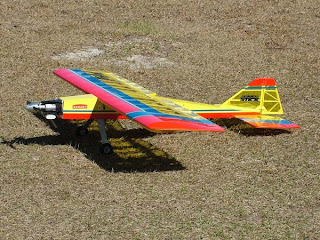It rained all morning! My wife was going to meet other women from our Life Group at church to see a chick flick so I invited all the husbands to go flying with me. I called one of my buddies at 12:30 and it was still raining too hard. I said I would call him back at 1:30 and make a definitive decision as to whether I was going to fly or not.
I had worked on the retracts on my Bridi Dirty Birdie and really wanted to get it in the air. Plus I REALLY wanted to fly my Ultra Stick again. 1:30 and the sky was much lighter and the rain had stopped. I called Ray and told him we were on.
I got to Tangerine field and the only guy there was Al Taylor who came down from Chicago to fly at Florida Jets next weekend. He brought a sweet little Kyosho Little Kelly pylon racer. Beautiful airplane and boy was it fast!
This is the first time I've flown at Tangerine Field without a strong crosswind. The wind was almost straight out of the north, only a couple degrees off running right down the runway.
Let me tell you, I had a blast flying today. I would take the Ultra Stick and do Harriers down the runway, without flaps and with flaps and even with the crow. It is amazing how well this plane flies! I was bringing the plane in low, at the speed of a fast walk without touching the ground. The takeoff distance with full flaps was about six feet! I can take off even in a shorter distance but my engine was cutting out a little when I poured the coals to it!
Another guy named Todd along with his dad Larry and a buddy Tim showed up with a little 40 sized Stinson Reliant. He hadn't flown in a couple of years and wanted to know if I would help him out by taking the plane off and flying it for him. The plane did not have a steerable tail wheel but I got it off and it was a little tail heavy and it had way too much elevator. We were able to reduce the throw on the elevator and Al had a couple ounces of lead we put on the nose. The plane flew a little better as long as you kept it under half throttle. Todd took it off and landed it. He did a great job. With a little more weight in the nose it will be a good plane.
I got the Dirty Birdie off the ground but it had WAY too much up elevator. I couldn't trim it out so I brought it in and changed the sub trim and that helped but then the steering came loose on the nosewheel so I put it up, will work on it later. I have the center of gravity just right on the plane. It landed very nicely for a pattern plane. I also had to adjust the idle and got it dialed in just right! I'll have photos of it soon.
If you want a plane that is a pure joy to fly, I would highly recommend the Ultra Stick 60!
Now I need a couple days in bed to get my back in order. I just can't go out and fly like I used to!
Now I need a couple days in bed to get my back in order. I just can't go out and fly like I used to!



















